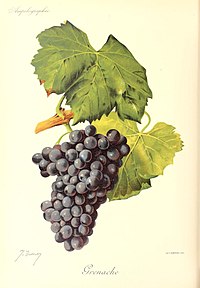
Photo from wikipedia
The major areas of the world where viticulture is practiced enjoy temperate or cool temperature climates. When wine grapes are grown in tropical regions, edaphoclimatic factors result in distinct grape… Click to show full abstract
The major areas of the world where viticulture is practiced enjoy temperate or cool temperature climates. When wine grapes are grown in tropical regions, edaphoclimatic factors result in distinct grape quality attributes, and production techniques also require significant adjustment. The objective of this study was to characterize the chemical compositions, in particular of phenolic compounds, of Syrah grapes grown in two location in northeast Brazil - these are also at widely different altitudes. A range of methods of phenolic extraction were used, along with classical chemical analyses including for organic acids, sugars, monomeric anthocyanins, flavonols, stilbene, condensed tannins and some of the monomeric and small oligomeric procyanidins. The regions and their diverse environments had a larger influence than harvest year. The grapes at higher altitude (Bahia, 1.100 m asl (metres above sea level) were characterized by higher levels of malic acid, anthocyanins and condensed tannins in the skins. The low-altitude grapes (Pernambuco, 350 m asl (metres above sea level) had higher levels of glucose, fructose, 3-O-acetylglucoside anthocyanins and condensed tannins in the seeds. Fruit composition was highly influenced by the region. In the low-altitude region, the grapes were characterized by higher tartaric and citric acid in the must, also of flavonols in skins and of tannins in the seeds. Meanwhile, the fruit from the high altitude, contained higher levels of malic and succinic acid in the must, and of anthocyanins and condensed tannins in the skins.
Journal Title: Food research international
Year Published: 2019
Link to full text (if available)
Share on Social Media: Sign Up to like & get
recommendations!